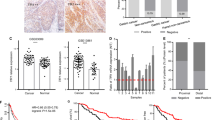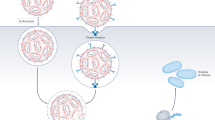Abstract
To overcome gene therapy barriers such as low transfection efficiency and nonspecific delivery, liposomal nanoparticles targeted by a single-chain antibody fragment to the transferrin receptor (TfRscFv) delivering wild-type (wt) human p53 (SGT-53) were developed for tumor-specific targeting. We hypothesize that SGT-53 in combination with gemcitabine will demonstrate enhanced therapeutic benefit in an in vivo metastatic pancreatic cancer model. Intrasplenic injection of 1 × 106 Panc02 murine pancreatic cancer cells was used to generate in vivo hepatic metastatic tumors. Nanoparticle localization was assessed by tail vein injection of TfRscFv with fluorescently labeled oligonucleotides (6-carboxyfluorescein phosphoramidite (6FAM) ODN) imaged by Xenogen IVIS 200 scan. SGT-53 (equivalent to 30 μg of p53 intravenously) and gemcitabine (20 mg/kg intraperitoneally) alone and in combination were administered biweekly and compared with untreated mice. Survival was determined by blinded daily assessment of morbidity. Human wtp53 expression and transferrin levels in the tumors were assessed by western blot analysis. Tumor burden was quantified by liver weight. Xenogen imaging demonstrated tumor-specific uptake of TfRscFv-6FAM ODN. Exogenous human wtp53 protein was detected in the SGT-53-treated tumors compared with control. Compared with untreated mice with metastatic tumors demonstrating median survival of 20 days, SGT-53, gemcitabine and the combination demonstrated improved median survival of 29, 30 and 37 days, respectively. The combination treatment prolonged median survival when compared with single drug treatment and decreased tumor burden. The tumor targeting liposomal-based SGT-53 nanoparticle is capable of sensitizing pancreatic cancer to conventional chemotherapy in pancreatic cancer models. This approach has the potential to be translated into a new, more effective therapy for pancreatic cancer. Further optimization is ongoing, moving towards a Phase 1B/2 clinical trial.
This is a preview of subscription content, access via your institution
Access options
Subscribe to this journal
Receive 12 print issues and online access
$259.00 per year
only $21.58 per issue
Buy this article
- Purchase on Springer Link
- Instant access to full article PDF
Prices may be subject to local taxes which are calculated during checkout





Similar content being viewed by others
References
Siegel R, Naishadham D, Jemal A . Cancer statistics, 2012. Cancer J Clini 2012; 62: 10–29.
Winter JM, Cameron JL, Campbell KA, Arnold MA, Chang DC, Coleman J et al. 1423 pancreaticoduodenectomies for pancreatic cancer: a single-institution experience. J Gastrointest Surg 2006; 10: 1199–1210 discussion 1210-1.
American Cancer Society Cancer Facts & Figures. American Cancer Society: Atlanta, GA, USA, 2010.
Saif MW . Pancreatic neoplasm in 2011: an update. J Pancreas 2011; 12: 316–321.
Moss RA, Lee C . Current and emerging therapies for the treatment of pancreatic cancer. Onco Targets Ther 2010; 3: 111–127.
Burris HA, Moore MJ, Andersen J, Green MR, Rothenberg ML, Modiano MR et al. Improvements in survival and clinical benefit with gemcitabine as first-line therapy for patients with advanced pancreas cancer: a randomized trial. J Clin Oncol 1997; 15: 2403–2413.
Ishii H, Furuse J, Nagase M, Yoshino M . Impact of gemcitabine on the treatment of metastatic pancreatic cancer. J Gastroenterol Hepatol 2005; 20: 62–66.
Pirollo KF, Zon G, Rait A, Zhou Q, Yu W, Hogrefe R et al. Tumor-targeting nanoimmunoliposome complex for short interfering RNA delivery. Hum Gene Ther 2006; 17: 117–124.
Gatter KC, Brown G, Trowbridge IS, Woolston RE, Mason DY . Transferrin receptors in human tissues: their distribution and possible clinical relevance. J Clin Pathol 1983; 36: 539–545.
Ryschich E, Huszty G, Knaebel HP, Hartel M, Buchler MW, Schmidt J . Transferrin receptor is a marker of malignant phenotype in human pancreatic cancer and in neuroendocrine carcinoma of the pancreas. Eur J Cancer 2004; 40: 1418–1422.
Pirollo KF, Rait A, Zhou Q, Hwang SH, Dagata JA, Zon G et al. Materializing the potential of small interfering RNA via a tumor-targeting nanodelivery system. Cancer Res 2007; 67: 2938–2943.
Pirollo KF, Dagata J, Wang P, Freedman M, Vladar A, Fricke S et al. A tumor-targeted nanodelivery system to improve early MRI detection of cancer. Mol Imag 2006; 5: 41–52.
Pirollo KF, Rait A, Zhou Q, Zhang XQ, Zhou J, Kim CS et al. Tumor-targeting nanocomplex delivery of novel tumor suppressor RB94 chemosensitizes bladder carcinoma cells in vitro and in vivo. Clin Cancer Res 2008; 14: 2190–2198.
Xu L, Huang CC, Huang W, Tang WH, Rait A, Yin YZ et al. Systemic tumor-targeted gene delivery by anti-transferrin receptor scFv-immunoliposomes. Mol Cancer Ther 2002; 1: 337–346.
Xu L, Tang WH, Huang CC, Alexander W, Xiang LM, Pirollo KF et al. Systemic p53 gene therapy of cancer with immunolipoplexes targeted by anti-transferrin receptor scFv. Mol Med 2001; 7: 723–734.
Rait AS, Pirollo KF, Xiang L, Ulick D, Chang EH . Tumor-targeting, systemically delivered antisense HER-2 chemosensitizes human breast cancer xenografts irrespective of HER-2 levels. Mol Med 2002; 8: 475–486.
Hwang SH, Rait A, Pirollo KF, Zhou Q, Yenugonda VM, Chinigo GM et al. Tumor-targeting nanodelivery enhances the anticancer activity of a novel quinazolinone analogue. Mol Cancer Therap 2008; 7: 559–568.
Freedman M, Chang EH, Zhou Q, Pirollo KF . Nanodelivery of MRI contrast agent enhances sensitivity of detection of lung cancer metastases. Acad Radiol 2009; 16: 627–637.
Yang C, Rait A, Pirollo KF, Dagata JA, Farkas N, Chang EH . Nanoimmunoliposome delivery of superparamagnetic iron oxide markedly enhances targeting and uptake in human cancer cells in vitro and in vivo. Nanomed Nanotechnol Biol Med 2008; 4: 318–329.
Dagata JA, Farkas N, Dennis CL, Shull RD, Hackley VA, Yang C et al. Physical characterization methods for iron oxide contrast agents encapsulated within a targeted liposome-based delivery system. Nanotechnology 2008; 19: 305101.
Riva CM . Restoration of wild-type p53 activity enhances the sensitivity of pleural metastasis to cisplatin through an apoptotic mechanism. Anticancer Res 2000; 20: 4463–4471.
Martins CP, Brown-Swigart L, Evan GI . Modeling the therapeutic efficacy of p53 restoration in tumors. Cell 2006; 127: 1323–1334.
Yu W, Pirollo KF, Yu B, Rait A, Xiang L, Huang W et al. Enhanced transfection efficiency of a systemically delivered tumor-targeting immunolipoplex by inclusion of a pH-sensitive histidylated oligolysine peptide. Nucleic Acids Res 2004; 32: e48.
Campbell MJ . Lipofection reagents prepared by a simple ethanol injection technique. BioTechniques 1995; 18: 1027–1032.
Little EC, Wang C, Watson PM, Watson DK, Cole DJ, Camp ER . Novel immunocompetent murine models representing advanced local and metastatic pancreatic cancer. J Surg Res 2012; 176: 359–366.
Xu L, Pirollo KF, Chang EH . Transferrin-liposome-mediated p53 sensitization of squamous cell carcinoma of the head and neck to radiation in vitro. Hum Gene Ther 1997; 8: 467–475.
Yu W, Pirollo KF, Rait A, Yu B, Xiang LM, Huang WQ et al. A sterically stabilized immunolipoplex for systemic administration of a therapeutic gene. Gene Therapy 2004; 11: 1434–1440.
Xu L, Pirollo KF, Chang EH . Tumor-targeted p53-gene therapy enhances the efficacy of conventional chemo/radiotherapy. J Control Rel 2001; 74: 115–128.
Xu L, Pirollo KF, Tang WH, Rait A, Chang EH . Transferrin-liposome-mediated systemic p53 gene therapy in combination with radiation results in regression of human head and neck cancer xenografts. Hum Gene Ther 1999; 10: 2941–2952.
Acknowledgements
This work was supported in part by the Flow Cytometry and Cell Sorting and Molecular imaging Shared Resource, Hollings Cancer Center, Medical University of South Carolina (P30 CA138313) and National Institutes of Health, 5R01CA123159-05 (DJC, DKW) and 1K08CA142904 (ERC).
Author information
Authors and Affiliations
Corresponding author
Ethics declarations
Competing interests
Drs Chang and Pirollo are two of the inventors of the described technology, for whom several patents owned by Georgetown University have been issued. The patents have been licensed to SynerGene Therapeutics for commercial development. Dr Chang owns equity interests in SynerGene and serves as a non-paid scientific consultant to SynerGene.
Rights and permissions
About this article
Cite this article
Camp, E., Wang, C., Little, E. et al. Transferrin receptor targeting nanomedicine delivering wild-type p53 gene sensitizes pancreatic cancer to gemcitabine therapy. Cancer Gene Ther 20, 222–228 (2013). https://doi.org/10.1038/cgt.2013.9
Received:
Revised:
Accepted:
Published:
Issue Date:
DOI: https://doi.org/10.1038/cgt.2013.9
Keywords
This article is cited by
-
GLRX3, a novel cancer stem cell-related secretory biomarker of pancreatic ductal adenocarcinoma
BMC Cancer (2021)
-
Recording 25 years of progress in Cancer Gene Therapy
Cancer Gene Therapy (2019)
-
Transferrin receptors-targeting nanocarriers for efficient targeted delivery and transcytosis of drugs into the brain tumors: a review of recent advancements and emerging trends
Drug Delivery and Translational Research (2018)
-
Nano-biomimetic carriers are implicated in mechanistic evaluation of intracellular gene delivery
Scientific Reports (2017)
-
Aptamer-Mediated Codelivery of Doxorubicin and NF-κB Decoy Enhances Chemosensitivity of Pancreatic Tumor Cells
Molecular Therapy - Nucleic Acids (2015)



